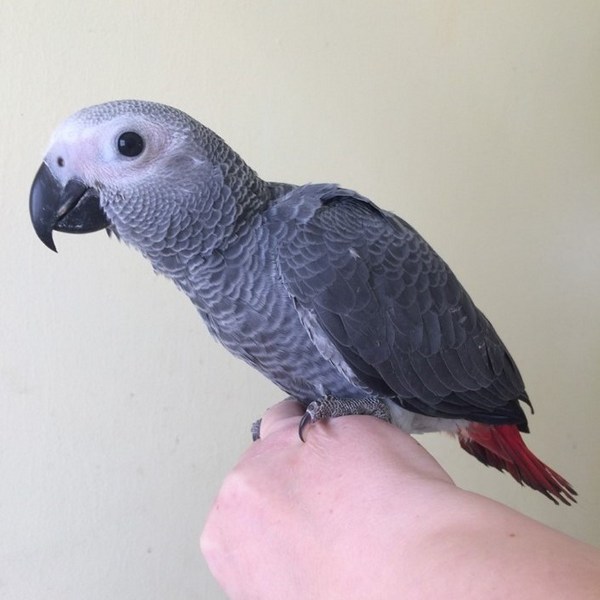[vc_row][vc_column][vc_empty_space height=”116px”][trx_columns margins=”” bottom=”large”][trx_column_item][trx_title type=”2″ align=”left” top=”tiny-” bottom=”medium”]African Grey Parrots for sale[/trx_title][vc_empty_space height=”5px”][vc_column_text el_class=”lh36 fs17″ css=”.vc_custom_1598795876181{margin-bottom: 50px !important;}”]The African grey parrot (Psittacus erithacus), is a highly intelligent bird, now commonly bred in captivity as a pet. This magnificent medium-sized bird is entirely grey with a strikingly red, short blunt tail. The African grey has a charming personality and is recognized as one of the best talkers among all pet parrots. With this extraordinary ability to imitate, some African greys develop extensive vocabularies of words, songs, verses, whistles, sneezes, coughs, and electronic sounds such as telephones and microwave ovens.
African Grey parrots lifespans are up to about 80 years.
These beautiful, good-natured birds make excellent companions and family pets for people who have the time to spend with these very social creatures. When handled often, African greys are generally interactive and affectionate. They will often continuously request petting and head scratches. African greys are very playful and enjoy climbing and chewing. It is essential to keep these smart birds busy, as boredom can lead to problems such as feather picking and screaming.
African greys bond easily, often with one member of the family or specifically to males or females. This one-on-one bond can occasionally lead to aggression towards others.
They exist two types of African grey parrots: the large grey Congo African grey, with a bright red tail, and the smaller, darker grey-colored Timneh African grey, with a maroon-colored tail.
Care
African Grey parrots, like any pet parrot, are very high-maintenance pets, as they require a great deal of personal attention. While numbers vary with each source, most agree that three hours out of cage daily and 45 minutes of physical interaction is the minimum attention required for good mental health. African Greys – particularly Congo African Greys – are known to be shy around strangers, and tend to bond solely with their primary caretaker if they do not interact with different people regularly. While inter-species friendships with other parrots are uncommon with African Greys, they require socialization with other parrots of any species.
African Greys require plenty of stimulating toys to keep them from becoming bored while confined to their cage. These toys should be rotated and switched out regularly to maintain the bird’s interest; because of their high intelligence, they quickly become tired of. For an African Grey spending most of its day in the cage, 36 “W x 24” D is good cage size. The height of a cage is typically not necessary, except in the case of playtop cages that are taller than the owner, in which case the bird can become territorial. An African Grey who spends most of its time on a play stand and uses the cage solely for sleeping only needs a cage large enough so that the bird’s wingspan doesn’t touch the cage’s sides and its head and tail do not touch the cage’s top and bottom, respectively. The bar-spacing should be ¾ inch to 1 inch. A companion African Grey should be kept in a bird-safe environment and placed in a busy part of the home, such as the living room, where the bird can occupy him- or herself in watching the household activities.
African Greys have special dietary requirements and should be fed plenty of calcium- and Vitamin A-rich foods, such as almonds, small amounts of cheese, or leafy greens like mustard greens, broccoli, etc. It is usual to give African grey parrots carefully calculated quantities of calcium and vitamin supplements. An excess of these added vitamins and minerals in an African Grey’s diet can lead to health problems. Only a few feathers should be clipped from the wings of an African Grey since they are heavy birds. Clipping too many feathers can severely impair flight and may lead to injuries as they may tend to crash to the ground. If very young birds are wing clipped, they may never gain full coordination and agility in flight.
African Grey Parrots babies available now! Males and females. Super sweet. All our birds are very well socialized and used to everyday household activity.
Browser through our African Grey Parrots for sale including African Grey Congo Parrot, African Grey Timneh Parrot,[/vc_column_text][vc_empty_space height=”10px”][trx_button align=”left” link=”/contacts/” class=”fl” top=”null”]Request a Call[/trx_button][trx_section class=”fl” top=”tiny”][vc_empty_space height=”6px”][trx_highlight type=”0″ font_size=”22px”]or Call Us: +1 (562) 285-7693 [/trx_highlight][/trx_section][/trx_column_item][trx_column_item][trx_image url=”680″][/trx_column_item][/trx_columns][vc_empty_space][/vc_column][/vc_row][vc_row full_width=”stretch_row” css=”.vc_custom_1467974253040{background-image: url(http://pets-grooming.axiomthemes.com/wp-content/uploads/2016/07/background-6.jpg?id=211) !important;}”][vc_column][vc_empty_space height=”56px”][trx_services style=”services-2″ scheme=”dark” cat=”21″ columns=”3″ count=”3″ readmore=”none” top=”large” bottom=”large”][trx_services_item title=”Service item 1″][/trx_services_item][trx_services_item title=”Service item 2″][/trx_services_item][trx_services_item title=”Service item 3″][/trx_services_item][trx_services_item title=”Service item 4″][/trx_services_item][/trx_services][vc_empty_space height=”22px”][/vc_column][/vc_row][vc_row full_width=”stretch_row” css=”.vc_custom_1470666162376{background-image: url(http://pets-grooming.axiomthemes.com/wp-content/uploads/2016/07/background-4.jpg?id=202) !important;background-position: center !important;background-repeat: no-repeat !important;background-size: cover !important;}”][vc_column css=”.vc_custom_1465478863764{margin-bottom: 1.5rem !important;}”][vc_empty_space height=”26px”][trx_testimonials cat=”0″ width=”671″ top=”large” bottom=”large” style_color=”style_color_light”][/trx_testimonials][/vc_column][/vc_row]

